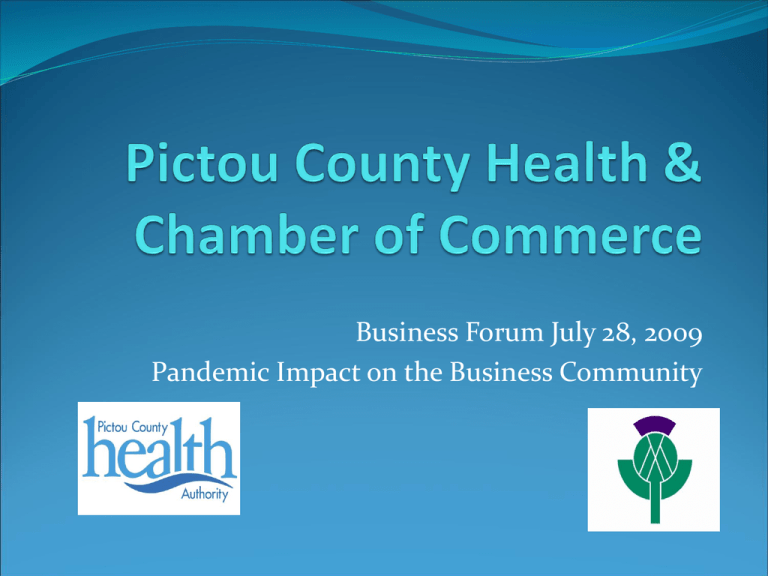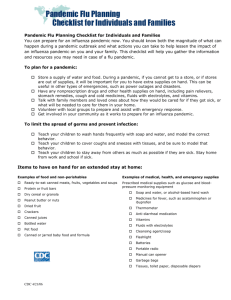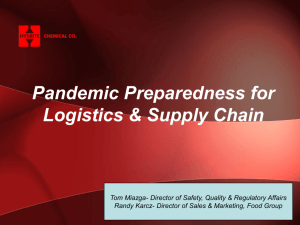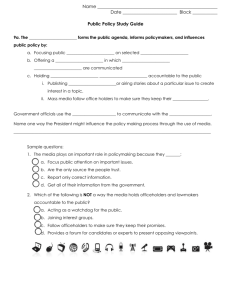Pandemic Impact on the Business Community
advertisement

Business Forum July 28, 2009 Pandemic Impact on the Business Community Objectives of Forum Share local impact of a pandemic including business risks 2. Clarify PCHA’s roles and responsibilities during pandemic response 3. Clarify government roles and responsibilities 4. Offer strategies for business continuity planning 1. What is a Pandemic? World wide outbreak of disease in humans with Community spread/highly contagious capabilities Little or no immunity (susceptible population) Ability to cause serious illness 3 major pandemics in the past century (Spanish flu of 1918 provides modeling predictions) Health organizations have been planning for years In June 2009, WHO declared Pandemic Level 6 Current Pandemic H1N1 virus meets pandemic criteria 94,512 cases worldwide 476 deaths (July, 2009) Human to human transmission Novel “A” strain virus Mild to severe illness 8972 cases in Canada, 151 cases in Nova Scotia ( July, 2009) Concern that virus will Meet with seasonal viruses and mix or mutate Increase in severity and communicability Flu Signs & Symptoms Symptoms of H1N1 are similar to those of seasonal flu Flu-like symptoms are fever and/or cough with one or more of: Unusual tiredness Head/muscle/joint aches Sore throat Mild cases stay at home When to Seek Medical Attention? When your symptoms rapidly worsen(within 24 hrs) Difficulty breathing Vulnerable population Pregnant (2nd or 3rd trimester) Postpartum ( 4 weeks or less) Underlying medical H1N1 Spread Characteristics Virus appears to spread the same way seasonal flu spreads Primarily through respiratory droplets coughing Sneezing Touching respiratory droplets on yourself, another person, or an object, then touching mucous membranes (e.g. Mouth, nose, eyes) without washing hands CDC, May 2009 What can we expect for Pictou County? Planning Assumptions: 1918 Data Pandemic Modeling Predictions 75% Infection Rate 30% absenteeism rate (peak 2 weeks) 25% Clinically ill (first wave) 50% will require out-patient care 0.4%-2.0% death rate 2 or more waves of outbreaks Each wave may last 6-8 weeks (2 week peak followed 1 month later by peak in mortalities) Second wave may be more virulant Community Impacts Decrease in services ( pharmacies, banking, food, fuel) Essential services may be unable to provide consistent levels Mutual aid may be limited or unavailable Increased need for some items (OTC meds; comfort foods, gloves and masks) Impact will depend on other events such as weather conditions/storms Economic “fall-out” uncertain Business Impacts High staff absenteeism (25-30%) for 2 weeks or more Illness Taking care of ill family members Fear of contracting virus at workplace Supplier disruptions Delivery disruptions Increased or decreased demand for business services Concerns over safety of workplace (staff and customers) Single points of failure ( critical staff or resources) PCHA Pandemic Procedure PCHA Pandemic Objectives To minimize illness and death rates within the district To slow the spread of widespread illness within the district To ensure essential health services are maintained PCHA Focus PCHA will focus on health response Impact assessment may require readjustment Vaccine may be unavailable or limited (DOH/DHPP) Antivirals have limited benefit (DOH/DHPP) Supplies (ex. PPE) will be limited (DOH/DHPP) Limited resources & staff will limit surge capacity Non-essential health service disruptions will be experienced PCHA Business Continuity PCHA will maintain an EOC & contact with provincial bodies as well as local Patients with flu symptoms will be diverted from hospital to alternative treatment facilities Facilities will be closed to visitors Co-horting of patients may occur Non-essential surgeries will be cancelled during peaks PCHA Business Continuity Clinic closures/services may occur Continuing care will be provided within existing facilities Between waves PCHA will balance catch-up of services with preparation for next waves PCHA Community Expectations Essential community services will be maintained by community response network Municipal EOC will be maintained and will provide and receive daily updates Municipal bodies, community agencies, local businesses will have developed pandemic plans Emergency Management Organization Local Government Response The responsibility for the health and welfare of the public rests with the elected officials of a municipal government according to the Emergency Management Act amended in 2005. Every municipality must be prepared to the extent of its own capabilities to meet the threat that may arise from emergencies or disasters. Because of close geographical proximity and shared response agencies, a Regional Emergency Management Organization (REMO) has been formed in Pictou County. Local Government Pandemic Objectives To support the lead agencies and emergency responders in the pandemic response (REMO) To support emergency support partners in large scale emergencies that occur in addition to pandemic (REMO) To ensure essential municipal government services are maintained (BCP) During a Pandemic REMO will: Support PCHA, the lead agency, for the health response to pandemic Operate a municipal Emergency Operations Center to coordinate information flow between community response partners and PCHA Maintain communication with Provincial Emergency Management Organization on non-health related issues (NS-EMO) Support public information messaging as directed by PCHA or NS-EMO REMO will also: Maintain “business as usual” for non-pandemic related events ( storms, large-scale events) Local Municipal Government Will activate Business Continuity Plans as the need arises (staff or supply shortages) Will maintain essential services (ex. sanitation; water treatment) Represent councils in REMO EOC as required Inform residents of service disruption through “usual” channels and REMO EOC Enforce Public health measures as directed by DOH/DHPP through PCHA (ex closures) Municipal Government Limitations Impact will depend on other events at the same time (storms, time of year) Staff absenteeism may be high and sudden (i.e. sick buildings) Supplies & resources may be limited Essential service disruptions may be experienced Strategies for Continuity Planning Business Continuity Objectives Maintain essential services and business functions during a pandemic Support the health response Support the community Survive despite business disruption Recover quickly once things get “back to normal” Business Continuity Plan A procedure that identifies how the business will continue to perform essential services/critical functions during times of disruption. Also Known As: Business Resumption Strategies/Plans Business Recovery Programs Disaster Recovery Plans Information/Data Back-up & Recovery Plans Strike Plans Often these plans identify alternative sites to operate and information retrieval Planning Steps Determine high, medium and low priority functions/services For each function identified, determine the resources (human and supplies/equipment) required to maintain Identify method to maintain high priority based on staged shut-down ( divert resources from low to high) Consider the specific impacts of a pandemic High Priorities Legislated activities Insurance requirements Contracted duty to provide Required to maintain health and safety of staff & public Highest profit/yield Customer perception Consider priorities for staff, other departments or business; general public Medium to Low Priorities Can be deferred for two week peak or longer without becoming High Priority Not crucial to profit sustainability over long term Can be deferred for 6-8 weeks or more Examples include; meetings; liaison with outside agencies/conferences; new profit lines; seasonal items; less popular brands/specialty items; Resources to maintain How many staff are required and what is their level of training/skill set What types of supplies are required from outside agencies What types of equipment must be available and maintained in working order What delivery schedules for supplies are essential Protecting High Priorities Divert resources from low and medium priorities to high prior to crisis level Prepare and take alternative action to prevent high priority shut down Track the “issues” & absenteeism in order to avoid surprise Pandemic may give you warning unlike other emergencies Coping with Pandemic Workplace Safety Will employees feel safe at work if there is a risk of droplet spread Will members of the public feel safe at your business Can you implement some changes to increase the safety by decreasing degree of contact (automation; screens; hand washing stations; workplace culture; increased phone & internet use) Increase cleaning schedules and target high transmission areas Consider shut down of close interaction areas to protect core business Staff Absenteeism Work from home strategies vs. stay at home strategies Consider vulnerable groups among employees Mitigate the impact in the areas you can (child support options; family supports; eliminate fear) Involve human resources ( policies & procedures; sick leave; Doctor’s notes) Cross training options Support flu preparedness & home flu kits Share plans with staff Supplier Disruption Who are your major suppliers Do your suppliers have plans to continue service with contracts in place that cover pandemic Will your suppliers notify you prior to sudden shutdown Are there alternative/back-up suppliers available Should you consider stockpiling key inventory Delivery Disruption What schedules do you now depend on Consider deliveries in and shipping that goes out Are there other delivery alternatives and back ups Multiple shipping/delivery methods (ground, air, courier, private trucking, postal service etc.) Consider strategic deliveries to key customers in early stages Changes in Demand How will your business change if the community is sick Will people need more from you Will people frequent your business less Are there parts of your operation that will increase and parts that will decrease Would social distancing affect how you do business Would closures such as gatherings or schools affect your business? Single Points of Failure Not necessarily an even distribution of sick workers Consider positions of authority and knowledge and build alternates Document “need to knows”, review manuals and protocols Job shadows and training Determine communication lines that may be disrupted if key people affected (ex. email contacts; passwords; security features) Build fail safe systems Sharing Resources Pandemic is a community problem that will require community solutions What do you have that someone else might need (staff; supplies; equipment; expertise; facilities) Build groups, associations, alliances , employee assistance solutions, good neighbour policies Consider resources for REMO response Summary Pandemic impacts present unique challenges Federal and Provincial agencies will provide strategic advice and suggestions PCHA will lead health response REMO will coordinate community issues and other emergencies Local governments will coordinate essential services Businesses will require business continuity plans tailored to pandemic impacts Individuals will require “good neighbour” strategies




